MGT605 Business Capstone: Proposal for Taxi Industry vs Uber
VerifiedAdded on 2023/06/11
|9
|2050
|433
Project
AI Summary
This business capstone project proposal delves into the challenges faced by the taxi industry in competing with Uber. It identifies Uber's strengths, such as high-quality service, fair pricing, and technological integration, and proposes strategies for the taxi industry to regain competitiveness. These strategies include enhancing safety measures, implementing flexible fare systems, increasing the availability of green cabs, and embracing digitalization through mobile applications and cashless transactions. The proposal also emphasizes the importance of driver training, security measures like CCTV surveillance, and effective promotional campaigns. The research methodology involves a positivism philosophy, a deductive approach, and a descriptive design, utilizing non-probability sampling and quantitative analysis to gather insights from both general people and taxi drivers. The ultimate goal is to provide actionable recommendations for the taxi industry to evolve and effectively compete with Uber in the modern transportation landscape. Desklib offers similar solved assignments for students.
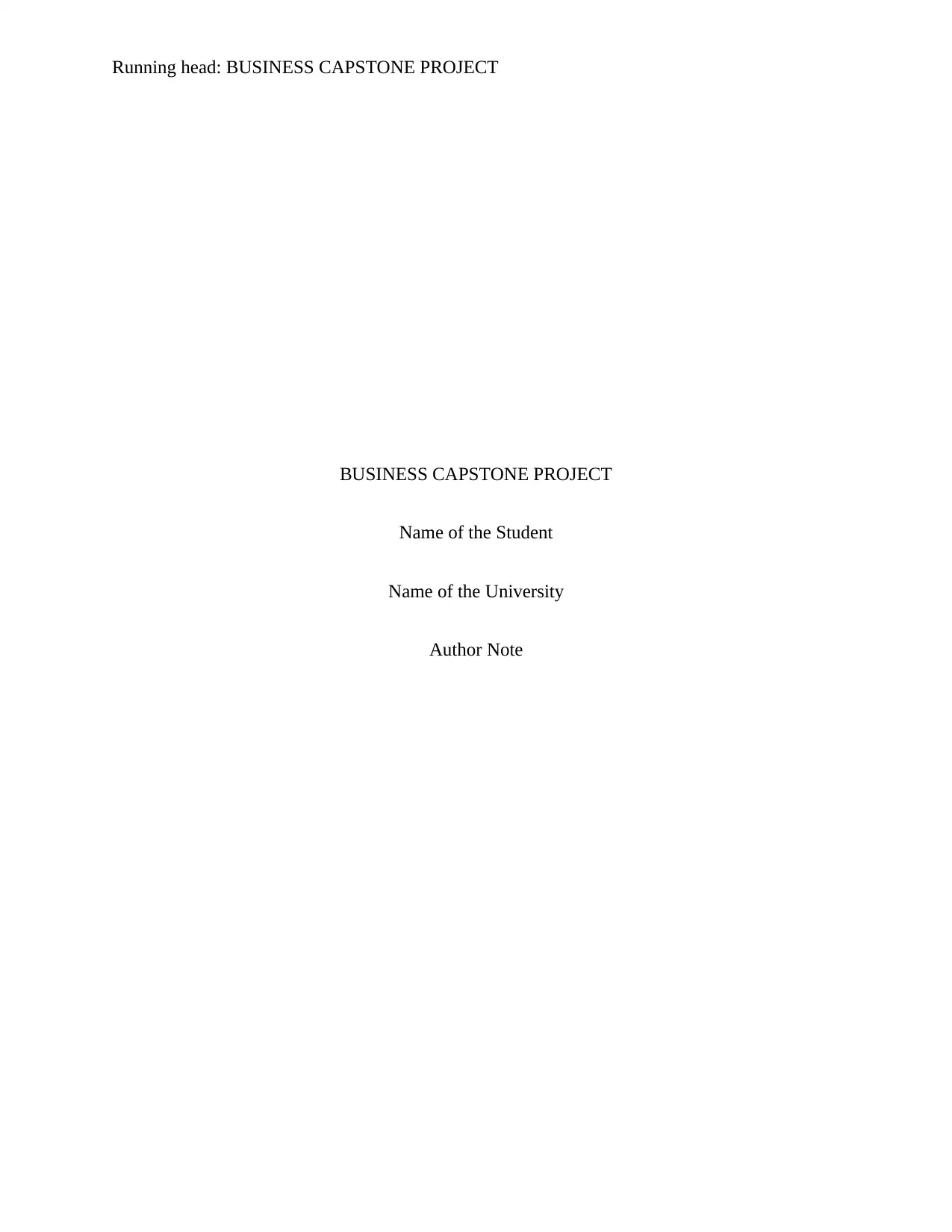
Running head: BUSINESS CAPSTONE PROJECT
BUSINESS CAPSTONE PROJECT
Name of the Student
Name of the University
Author Note
BUSINESS CAPSTONE PROJECT
Name of the Student
Name of the University
Author Note
Paraphrase This Document
Need a fresh take? Get an instant paraphrase of this document with our AI Paraphraser

1BUSINESS CAPSTONE PROJECT
Table of Contents
Introduction......................................................................................................................................2
Problem statement...........................................................................................................................2
Research Objective..........................................................................................................................2
Research Questions..........................................................................................................................3
Literature Review............................................................................................................................3
Benefits of Uber rather than Taxi................................................................................................3
Different ways in which taxi industry can deliver a competition................................................4
Methodology....................................................................................................................................6
Timetable.........................................................................................................................................7
Conclusion.......................................................................................................................................7
References........................................................................................................................................8
Table of Contents
Introduction......................................................................................................................................2
Problem statement...........................................................................................................................2
Research Objective..........................................................................................................................2
Research Questions..........................................................................................................................3
Literature Review............................................................................................................................3
Benefits of Uber rather than Taxi................................................................................................3
Different ways in which taxi industry can deliver a competition................................................4
Methodology....................................................................................................................................6
Timetable.........................................................................................................................................7
Conclusion.......................................................................................................................................7
References........................................................................................................................................8

2BUSINESS CAPSTONE PROJECT
Topic: Chances of Taxi industry to compete with Uber
Introduction
Time is the big factor in this globalised world and people have not enough time to spare
or to wait for anything. They need it now or never, this thought process has been implemented
specifically by some of the business companies. Uber is one of that, as the company delivers taxi
for people in a quick manner and that is the reason most of the people rely on that. The
successful business market of the company has evolved its marketing position as people are not
satisfied to wait for general cabs. The reach of Uber is now $62 billion and that officially
decimating the Taxi industry (Wallsten, 2015). The facilities that Uber has made in worldwide
are phenomenal as this is a kind of change behaviour that aligned with the human perspective.
Problem statement
In that situation, the problem statement of the proposal is to deliver the possible ways that
taxi industry can come up to make some competition to Uber. The social platforms are also
aligning with Uber and most of the Smartphone's applications are joined with the process, where
the industry of taxi is not having such amenities with it. So the development of entire process and
better movement in taxi industry is the key matter that will discuss in this paper.
Research Objective
To evaluate the process of possible chances that taxi industry will challenge Uber.
To differentiate the aspects that taxi industry is lagging behind Uber.
To make the focus on the influences that taxi industry will get and the impact on their
employees' future.
Topic: Chances of Taxi industry to compete with Uber
Introduction
Time is the big factor in this globalised world and people have not enough time to spare
or to wait for anything. They need it now or never, this thought process has been implemented
specifically by some of the business companies. Uber is one of that, as the company delivers taxi
for people in a quick manner and that is the reason most of the people rely on that. The
successful business market of the company has evolved its marketing position as people are not
satisfied to wait for general cabs. The reach of Uber is now $62 billion and that officially
decimating the Taxi industry (Wallsten, 2015). The facilities that Uber has made in worldwide
are phenomenal as this is a kind of change behaviour that aligned with the human perspective.
Problem statement
In that situation, the problem statement of the proposal is to deliver the possible ways that
taxi industry can come up to make some competition to Uber. The social platforms are also
aligning with Uber and most of the Smartphone's applications are joined with the process, where
the industry of taxi is not having such amenities with it. So the development of entire process and
better movement in taxi industry is the key matter that will discuss in this paper.
Research Objective
To evaluate the process of possible chances that taxi industry will challenge Uber.
To differentiate the aspects that taxi industry is lagging behind Uber.
To make the focus on the influences that taxi industry will get and the impact on their
employees' future.
⊘ This is a preview!⊘
Do you want full access?
Subscribe today to unlock all pages.

Trusted by 1+ million students worldwide
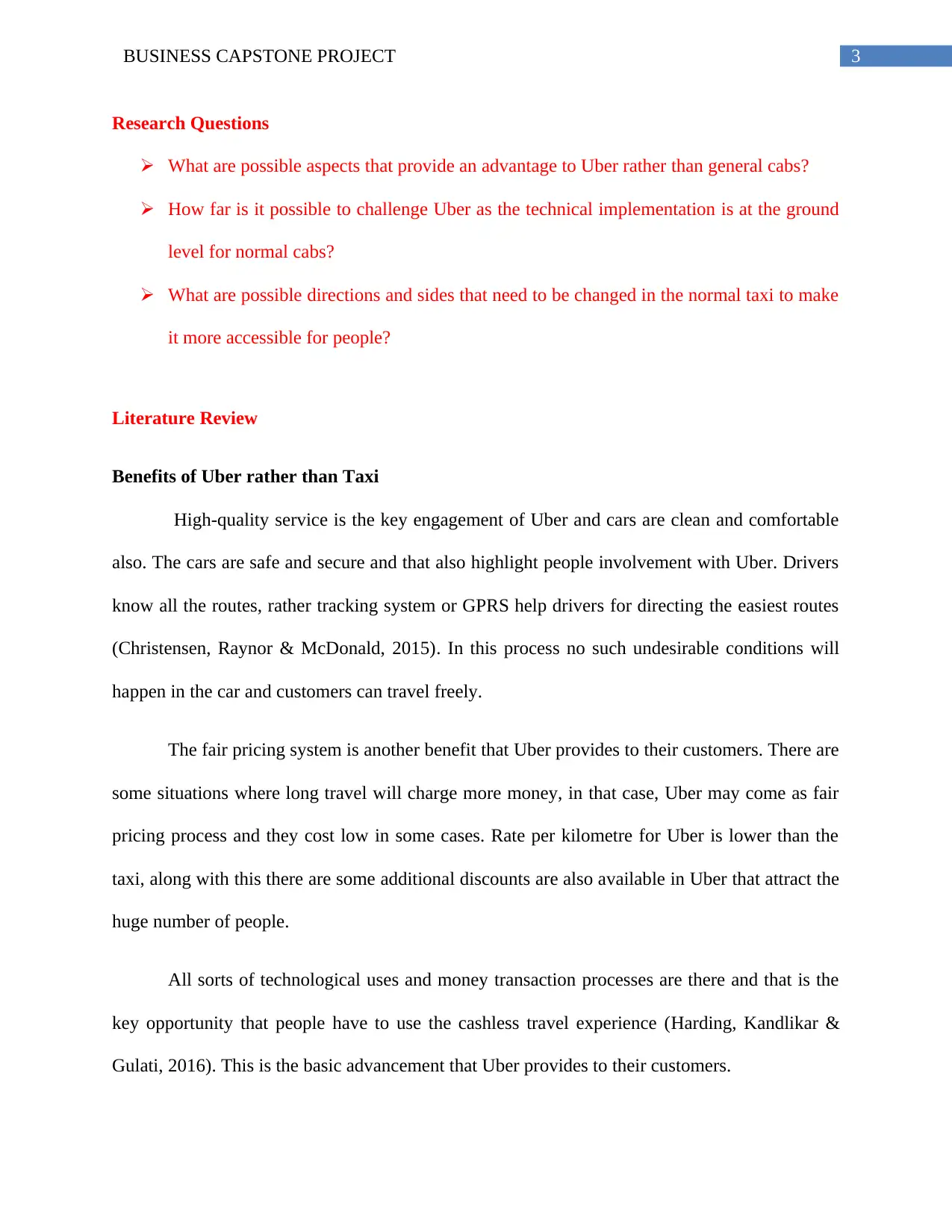
3BUSINESS CAPSTONE PROJECT
Research Questions
What are possible aspects that provide an advantage to Uber rather than general cabs?
How far is it possible to challenge Uber as the technical implementation is at the ground
level for normal cabs?
What are possible directions and sides that need to be changed in the normal taxi to make
it more accessible for people?
Literature Review
Benefits of Uber rather than Taxi
High-quality service is the key engagement of Uber and cars are clean and comfortable
also. The cars are safe and secure and that also highlight people involvement with Uber. Drivers
know all the routes, rather tracking system or GPRS help drivers for directing the easiest routes
(Christensen, Raynor & McDonald, 2015). In this process no such undesirable conditions will
happen in the car and customers can travel freely.
The fair pricing system is another benefit that Uber provides to their customers. There are
some situations where long travel will charge more money, in that case, Uber may come as fair
pricing process and they cost low in some cases. Rate per kilometre for Uber is lower than the
taxi, along with this there are some additional discounts are also available in Uber that attract the
huge number of people.
All sorts of technological uses and money transaction processes are there and that is the
key opportunity that people have to use the cashless travel experience (Harding, Kandlikar &
Gulati, 2016). This is the basic advancement that Uber provides to their customers.
Research Questions
What are possible aspects that provide an advantage to Uber rather than general cabs?
How far is it possible to challenge Uber as the technical implementation is at the ground
level for normal cabs?
What are possible directions and sides that need to be changed in the normal taxi to make
it more accessible for people?
Literature Review
Benefits of Uber rather than Taxi
High-quality service is the key engagement of Uber and cars are clean and comfortable
also. The cars are safe and secure and that also highlight people involvement with Uber. Drivers
know all the routes, rather tracking system or GPRS help drivers for directing the easiest routes
(Christensen, Raynor & McDonald, 2015). In this process no such undesirable conditions will
happen in the car and customers can travel freely.
The fair pricing system is another benefit that Uber provides to their customers. There are
some situations where long travel will charge more money, in that case, Uber may come as fair
pricing process and they cost low in some cases. Rate per kilometre for Uber is lower than the
taxi, along with this there are some additional discounts are also available in Uber that attract the
huge number of people.
All sorts of technological uses and money transaction processes are there and that is the
key opportunity that people have to use the cashless travel experience (Harding, Kandlikar &
Gulati, 2016). This is the basic advancement that Uber provides to their customers.
Paraphrase This Document
Need a fresh take? Get an instant paraphrase of this document with our AI Paraphraser
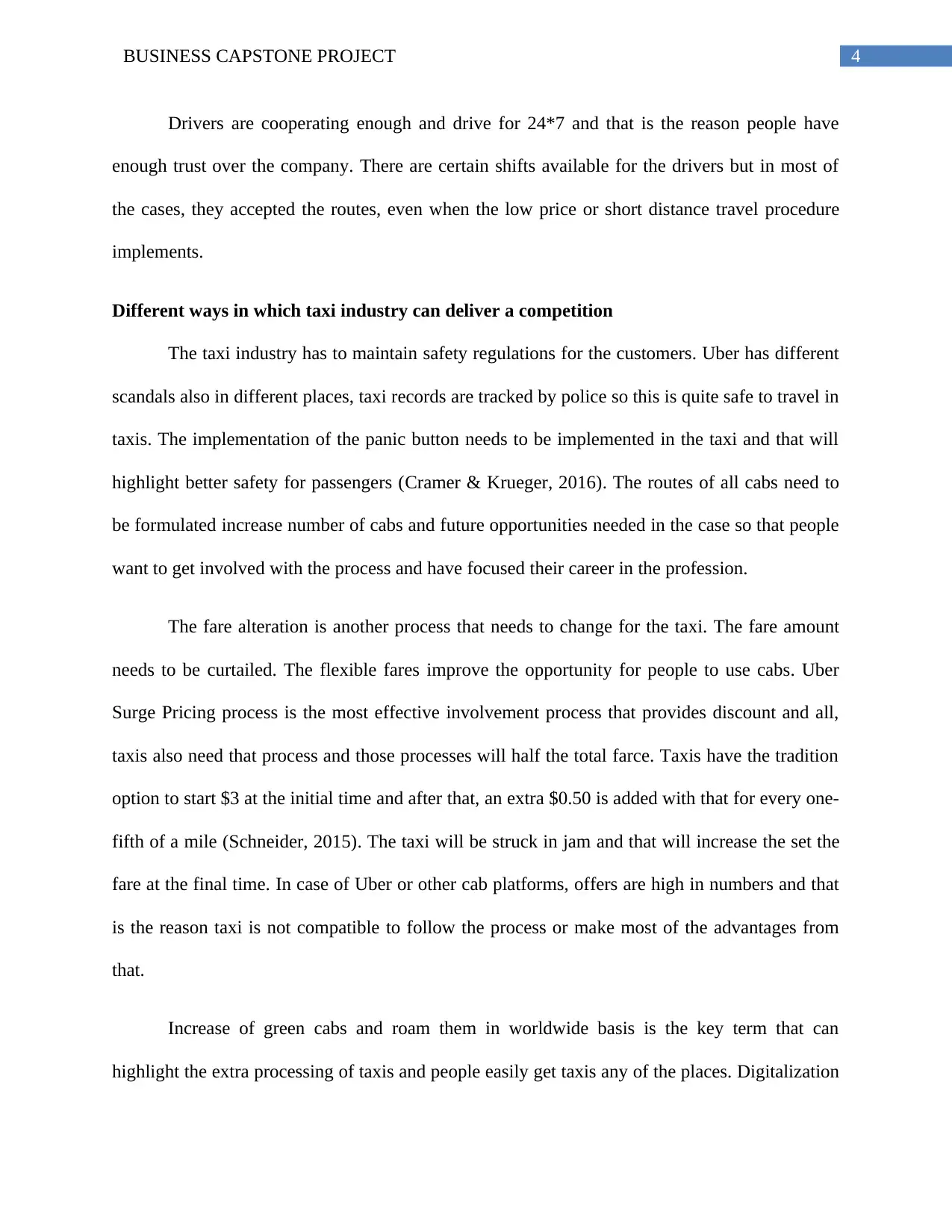
4BUSINESS CAPSTONE PROJECT
Drivers are cooperating enough and drive for 24*7 and that is the reason people have
enough trust over the company. There are certain shifts available for the drivers but in most of
the cases, they accepted the routes, even when the low price or short distance travel procedure
implements.
Different ways in which taxi industry can deliver a competition
The taxi industry has to maintain safety regulations for the customers. Uber has different
scandals also in different places, taxi records are tracked by police so this is quite safe to travel in
taxis. The implementation of the panic button needs to be implemented in the taxi and that will
highlight better safety for passengers (Cramer & Krueger, 2016). The routes of all cabs need to
be formulated increase number of cabs and future opportunities needed in the case so that people
want to get involved with the process and have focused their career in the profession.
The fare alteration is another process that needs to change for the taxi. The fare amount
needs to be curtailed. The flexible fares improve the opportunity for people to use cabs. Uber
Surge Pricing process is the most effective involvement process that provides discount and all,
taxis also need that process and those processes will half the total farce. Taxis have the tradition
option to start $3 at the initial time and after that, an extra $0.50 is added with that for every one-
fifth of a mile (Schneider, 2015). The taxi will be struck in jam and that will increase the set the
fare at the final time. In case of Uber or other cab platforms, offers are high in numbers and that
is the reason taxi is not compatible to follow the process or make most of the advantages from
that.
Increase of green cabs and roam them in worldwide basis is the key term that can
highlight the extra processing of taxis and people easily get taxis any of the places. Digitalization
Drivers are cooperating enough and drive for 24*7 and that is the reason people have
enough trust over the company. There are certain shifts available for the drivers but in most of
the cases, they accepted the routes, even when the low price or short distance travel procedure
implements.
Different ways in which taxi industry can deliver a competition
The taxi industry has to maintain safety regulations for the customers. Uber has different
scandals also in different places, taxi records are tracked by police so this is quite safe to travel in
taxis. The implementation of the panic button needs to be implemented in the taxi and that will
highlight better safety for passengers (Cramer & Krueger, 2016). The routes of all cabs need to
be formulated increase number of cabs and future opportunities needed in the case so that people
want to get involved with the process and have focused their career in the profession.
The fare alteration is another process that needs to change for the taxi. The fare amount
needs to be curtailed. The flexible fares improve the opportunity for people to use cabs. Uber
Surge Pricing process is the most effective involvement process that provides discount and all,
taxis also need that process and those processes will half the total farce. Taxis have the tradition
option to start $3 at the initial time and after that, an extra $0.50 is added with that for every one-
fifth of a mile (Schneider, 2015). The taxi will be struck in jam and that will increase the set the
fare at the final time. In case of Uber or other cab platforms, offers are high in numbers and that
is the reason taxi is not compatible to follow the process or make most of the advantages from
that.
Increase of green cabs and roam them in worldwide basis is the key term that can
highlight the extra processing of taxis and people easily get taxis any of the places. Digitalization
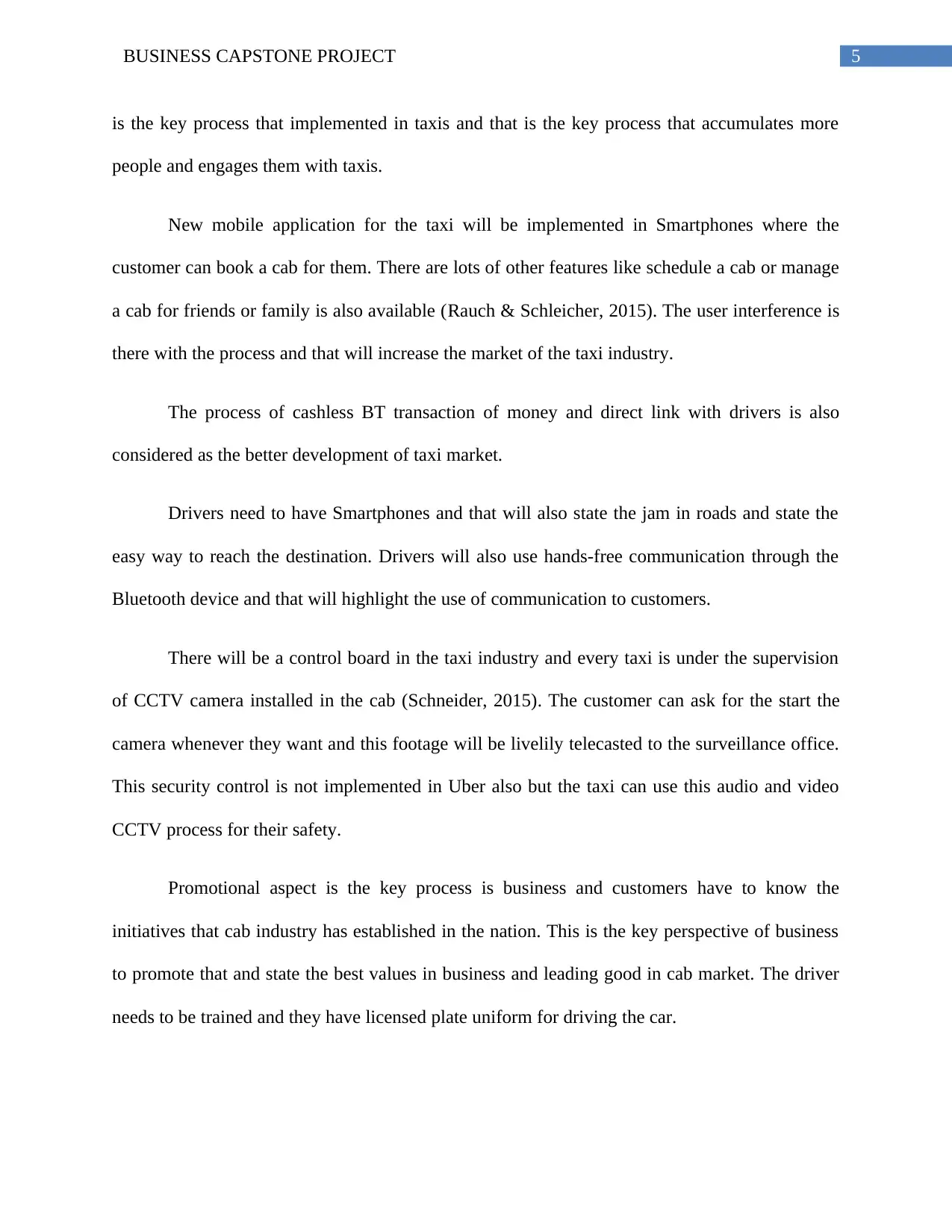
5BUSINESS CAPSTONE PROJECT
is the key process that implemented in taxis and that is the key process that accumulates more
people and engages them with taxis.
New mobile application for the taxi will be implemented in Smartphones where the
customer can book a cab for them. There are lots of other features like schedule a cab or manage
a cab for friends or family is also available (Rauch & Schleicher, 2015). The user interference is
there with the process and that will increase the market of the taxi industry.
The process of cashless BT transaction of money and direct link with drivers is also
considered as the better development of taxi market.
Drivers need to have Smartphones and that will also state the jam in roads and state the
easy way to reach the destination. Drivers will also use hands-free communication through the
Bluetooth device and that will highlight the use of communication to customers.
There will be a control board in the taxi industry and every taxi is under the supervision
of CCTV camera installed in the cab (Schneider, 2015). The customer can ask for the start the
camera whenever they want and this footage will be livelily telecasted to the surveillance office.
This security control is not implemented in Uber also but the taxi can use this audio and video
CCTV process for their safety.
Promotional aspect is the key process is business and customers have to know the
initiatives that cab industry has established in the nation. This is the key perspective of business
to promote that and state the best values in business and leading good in cab market. The driver
needs to be trained and they have licensed plate uniform for driving the car.
is the key process that implemented in taxis and that is the key process that accumulates more
people and engages them with taxis.
New mobile application for the taxi will be implemented in Smartphones where the
customer can book a cab for them. There are lots of other features like schedule a cab or manage
a cab for friends or family is also available (Rauch & Schleicher, 2015). The user interference is
there with the process and that will increase the market of the taxi industry.
The process of cashless BT transaction of money and direct link with drivers is also
considered as the better development of taxi market.
Drivers need to have Smartphones and that will also state the jam in roads and state the
easy way to reach the destination. Drivers will also use hands-free communication through the
Bluetooth device and that will highlight the use of communication to customers.
There will be a control board in the taxi industry and every taxi is under the supervision
of CCTV camera installed in the cab (Schneider, 2015). The customer can ask for the start the
camera whenever they want and this footage will be livelily telecasted to the surveillance office.
This security control is not implemented in Uber also but the taxi can use this audio and video
CCTV process for their safety.
Promotional aspect is the key process is business and customers have to know the
initiatives that cab industry has established in the nation. This is the key perspective of business
to promote that and state the best values in business and leading good in cab market. The driver
needs to be trained and they have licensed plate uniform for driving the car.
⊘ This is a preview!⊘
Do you want full access?
Subscribe today to unlock all pages.

Trusted by 1+ million students worldwide
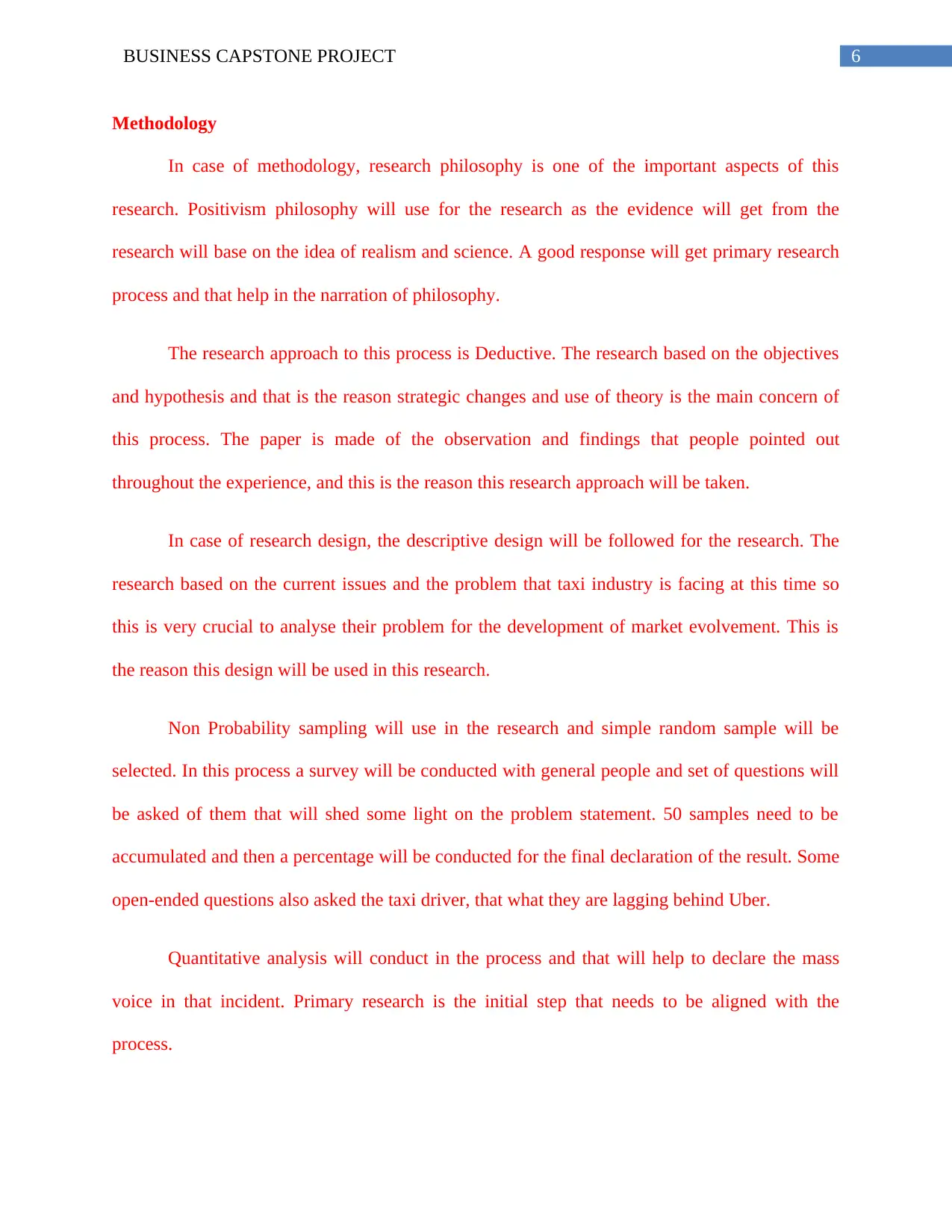
6BUSINESS CAPSTONE PROJECT
Methodology
In case of methodology, research philosophy is one of the important aspects of this
research. Positivism philosophy will use for the research as the evidence will get from the
research will base on the idea of realism and science. A good response will get primary research
process and that help in the narration of philosophy.
The research approach to this process is Deductive. The research based on the objectives
and hypothesis and that is the reason strategic changes and use of theory is the main concern of
this process. The paper is made of the observation and findings that people pointed out
throughout the experience, and this is the reason this research approach will be taken.
In case of research design, the descriptive design will be followed for the research. The
research based on the current issues and the problem that taxi industry is facing at this time so
this is very crucial to analyse their problem for the development of market evolvement. This is
the reason this design will be used in this research.
Non Probability sampling will use in the research and simple random sample will be
selected. In this process a survey will be conducted with general people and set of questions will
be asked of them that will shed some light on the problem statement. 50 samples need to be
accumulated and then a percentage will be conducted for the final declaration of the result. Some
open-ended questions also asked the taxi driver, that what they are lagging behind Uber.
Quantitative analysis will conduct in the process and that will help to declare the mass
voice in that incident. Primary research is the initial step that needs to be aligned with the
process.
Methodology
In case of methodology, research philosophy is one of the important aspects of this
research. Positivism philosophy will use for the research as the evidence will get from the
research will base on the idea of realism and science. A good response will get primary research
process and that help in the narration of philosophy.
The research approach to this process is Deductive. The research based on the objectives
and hypothesis and that is the reason strategic changes and use of theory is the main concern of
this process. The paper is made of the observation and findings that people pointed out
throughout the experience, and this is the reason this research approach will be taken.
In case of research design, the descriptive design will be followed for the research. The
research based on the current issues and the problem that taxi industry is facing at this time so
this is very crucial to analyse their problem for the development of market evolvement. This is
the reason this design will be used in this research.
Non Probability sampling will use in the research and simple random sample will be
selected. In this process a survey will be conducted with general people and set of questions will
be asked of them that will shed some light on the problem statement. 50 samples need to be
accumulated and then a percentage will be conducted for the final declaration of the result. Some
open-ended questions also asked the taxi driver, that what they are lagging behind Uber.
Quantitative analysis will conduct in the process and that will help to declare the mass
voice in that incident. Primary research is the initial step that needs to be aligned with the
process.
Paraphrase This Document
Need a fresh take? Get an instant paraphrase of this document with our AI Paraphraser
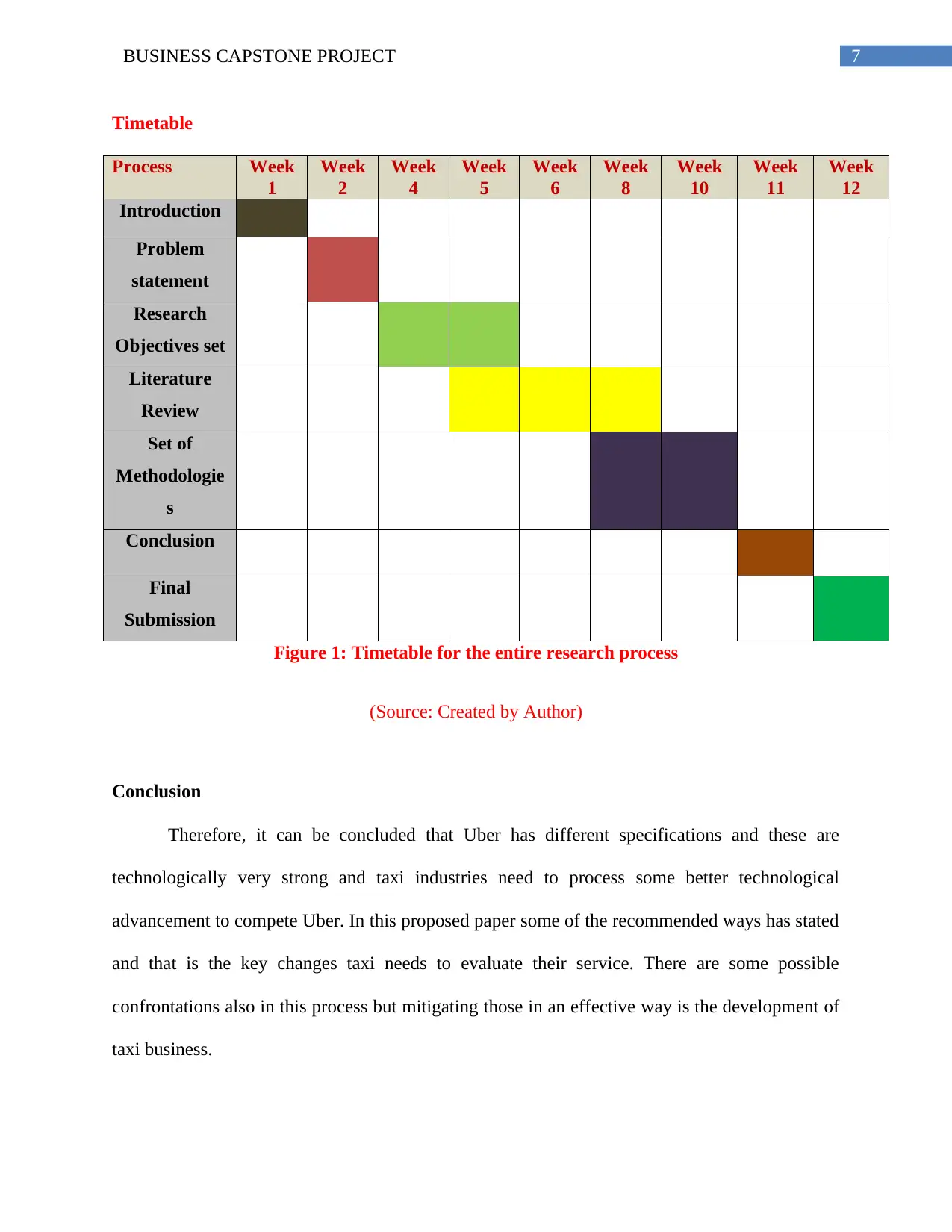
7BUSINESS CAPSTONE PROJECT
Timetable
Process Week
1
Week
2
Week
4
Week
5
Week
6
Week
8
Week
10
Week
11
Week
12
Introduction
Problem
statement
Research
Objectives set
Literature
Review
Set of
Methodologie
s
Conclusion
Final
Submission
Figure 1: Timetable for the entire research process
(Source: Created by Author)
Conclusion
Therefore, it can be concluded that Uber has different specifications and these are
technologically very strong and taxi industries need to process some better technological
advancement to compete Uber. In this proposed paper some of the recommended ways has stated
and that is the key changes taxi needs to evaluate their service. There are some possible
confrontations also in this process but mitigating those in an effective way is the development of
taxi business.
Timetable
Process Week
1
Week
2
Week
4
Week
5
Week
6
Week
8
Week
10
Week
11
Week
12
Introduction
Problem
statement
Research
Objectives set
Literature
Review
Set of
Methodologie
s
Conclusion
Final
Submission
Figure 1: Timetable for the entire research process
(Source: Created by Author)
Conclusion
Therefore, it can be concluded that Uber has different specifications and these are
technologically very strong and taxi industries need to process some better technological
advancement to compete Uber. In this proposed paper some of the recommended ways has stated
and that is the key changes taxi needs to evaluate their service. There are some possible
confrontations also in this process but mitigating those in an effective way is the development of
taxi business.
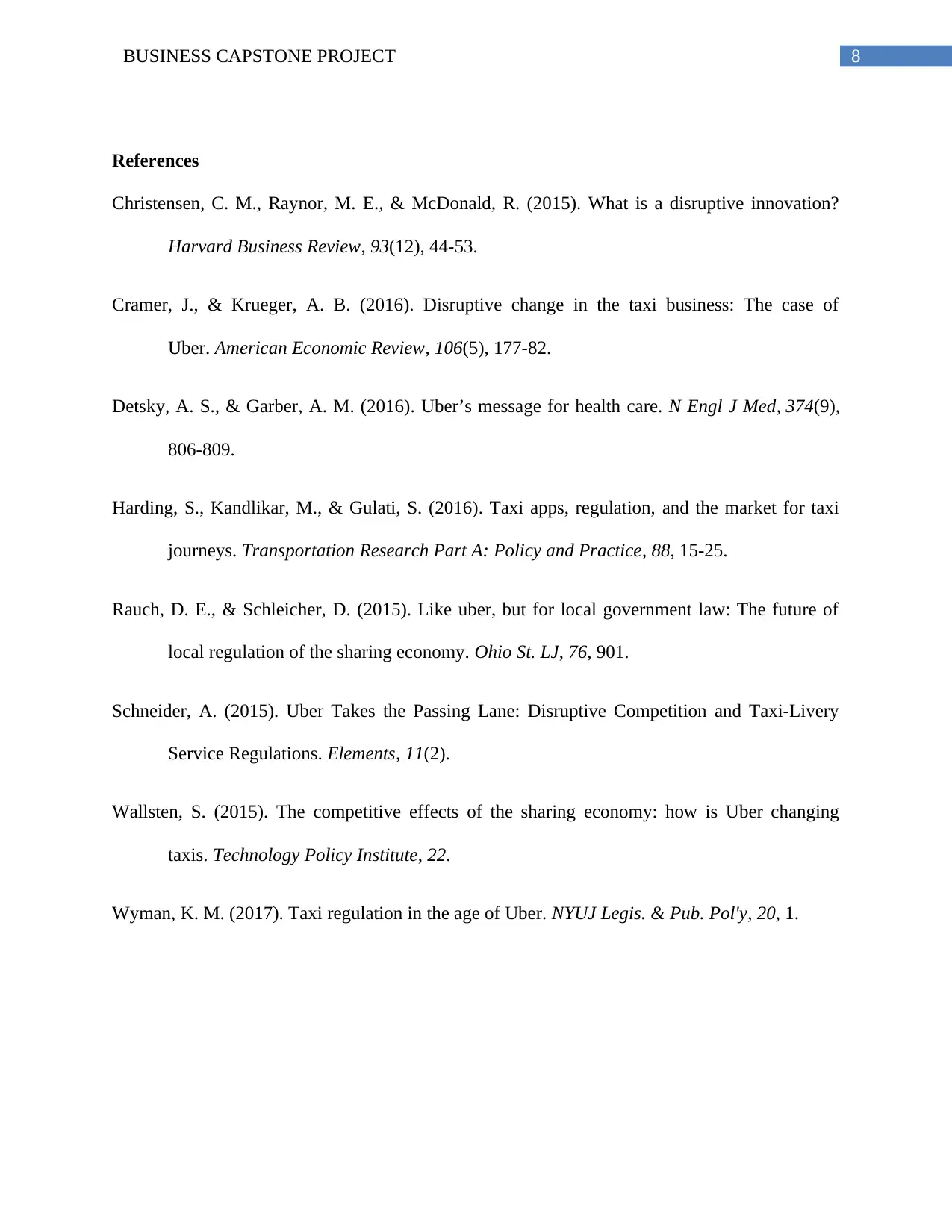
8BUSINESS CAPSTONE PROJECT
References
Christensen, C. M., Raynor, M. E., & McDonald, R. (2015). What is a disruptive innovation?
Harvard Business Review, 93(12), 44-53.
Cramer, J., & Krueger, A. B. (2016). Disruptive change in the taxi business: The case of
Uber. American Economic Review, 106(5), 177-82.
Detsky, A. S., & Garber, A. M. (2016). Uber’s message for health care. N Engl J Med, 374(9),
806-809.
Harding, S., Kandlikar, M., & Gulati, S. (2016). Taxi apps, regulation, and the market for taxi
journeys. Transportation Research Part A: Policy and Practice, 88, 15-25.
Rauch, D. E., & Schleicher, D. (2015). Like uber, but for local government law: The future of
local regulation of the sharing economy. Ohio St. LJ, 76, 901.
Schneider, A. (2015). Uber Takes the Passing Lane: Disruptive Competition and Taxi-Livery
Service Regulations. Elements, 11(2).
Wallsten, S. (2015). The competitive effects of the sharing economy: how is Uber changing
taxis. Technology Policy Institute, 22.
Wyman, K. M. (2017). Taxi regulation in the age of Uber. NYUJ Legis. & Pub. Pol'y, 20, 1.
References
Christensen, C. M., Raynor, M. E., & McDonald, R. (2015). What is a disruptive innovation?
Harvard Business Review, 93(12), 44-53.
Cramer, J., & Krueger, A. B. (2016). Disruptive change in the taxi business: The case of
Uber. American Economic Review, 106(5), 177-82.
Detsky, A. S., & Garber, A. M. (2016). Uber’s message for health care. N Engl J Med, 374(9),
806-809.
Harding, S., Kandlikar, M., & Gulati, S. (2016). Taxi apps, regulation, and the market for taxi
journeys. Transportation Research Part A: Policy and Practice, 88, 15-25.
Rauch, D. E., & Schleicher, D. (2015). Like uber, but for local government law: The future of
local regulation of the sharing economy. Ohio St. LJ, 76, 901.
Schneider, A. (2015). Uber Takes the Passing Lane: Disruptive Competition and Taxi-Livery
Service Regulations. Elements, 11(2).
Wallsten, S. (2015). The competitive effects of the sharing economy: how is Uber changing
taxis. Technology Policy Institute, 22.
Wyman, K. M. (2017). Taxi regulation in the age of Uber. NYUJ Legis. & Pub. Pol'y, 20, 1.
⊘ This is a preview!⊘
Do you want full access?
Subscribe today to unlock all pages.

Trusted by 1+ million students worldwide
1 out of 9
Related Documents
Your All-in-One AI-Powered Toolkit for Academic Success.
+13062052269
info@desklib.com
Available 24*7 on WhatsApp / Email
![[object Object]](/_next/static/media/star-bottom.7253800d.svg)
Unlock your academic potential
Copyright © 2020–2025 A2Z Services. All Rights Reserved. Developed and managed by ZUCOL.





